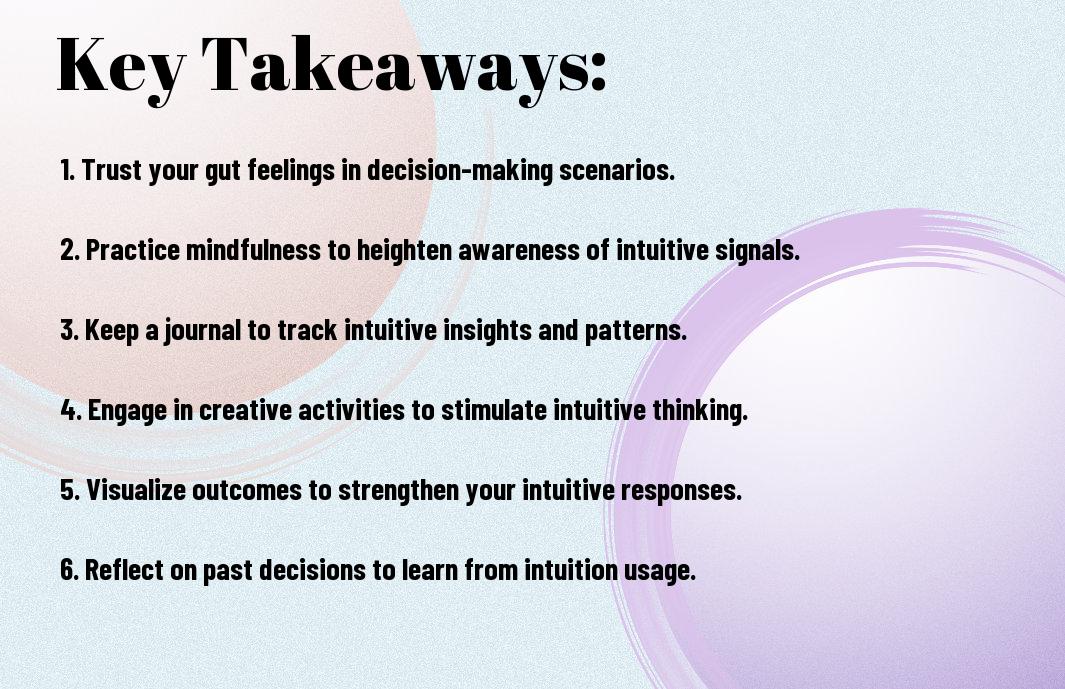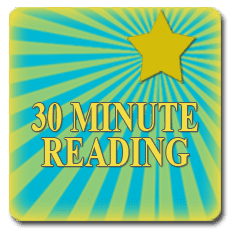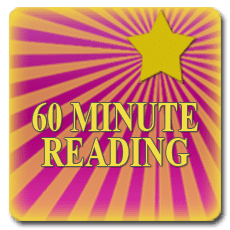Intuition Building Exercises
Intuition Building Exercises can significantly improve your decision-making skills. By engaging in simple yet effective activities, you can tap into your inner guidance, leading to more confident and informed choices. Whether you’re facing small daily decisions or major life changes, these exercises will help you cultivate your intuition and trust your instincts. Prepare to begin on a journey that will empower you to listen to your gut feeling and enhance your overall decision-making ability.
Key Takeaways:
- Engage in mindfulness practices to sharpen your awareness and attunement to your inner voice.
- Utilize journaling as a tool to reflect on your thoughts and feelings, aiding clarity in decision-making.
- Practice visualization by imagining different decision outcomes to assess emotional and intuitive reactions.
- Maintain a balance between analytical thinking and intuitive insights to create a well-rounded decision-making approach.
- Challenge yourself with spontaneous decisions to build confidence in your intuitive abilities.
- Observe and analyze past decisions to identify patterns in your intuitive responses and outcomes.
- Set aside specific time for quiet reflection, allowing intuition to surface without external distractions.
Understanding Intuition
While many people view intuition as a mystical or unscientific ability, it is fundamentally rooted in your brain’s complex processes. Intuition is your brain’s way of drawing upon past experiences, knowledge, and subconscious signals to guide you in decision-making. When faced with a choice, your brain rapidly analyzes information—often without conscious awareness—allowing you to arrive at conclusions that feel instinctive. By understanding how intuition operates, you can start harnessing its power more effectively in your daily life.
The Science of Intuition
Intuition stems from a series of neurological processes and cognitive patterns that function outside of your conscious awareness. The dual-processing theory indicates that your brain has two systems: one that operates on a more analytical, deliberate level, and another that reacts instinctively and rapidly. This dual-system approach means that your intuitive judgments are shaped by amassed experiences stored in your brain, which can be beneficial in making quick decisions. These instinctual insights often arise from your subconscious compiling data points and patterns you may not even realize are relevant.
The Role of Intuition in Decision Making
Scientific studies have shown that intuition can significantly enhance your decision-making process, especially in complex situations that require quick thinking. While analytical reasoning has its merits, relying solely on logical processing can sometimes lead to analysis paralysis, where you become overwhelmed by options. Integrating intuition allows you to navigate your choices with greater fluidity, as it taps into your innate wisdom and past experiences, often leading to more effective outcomes.
Understanding how intuition building exercises influences decision-making can empower you to make informed choices more confidently. Accepting that your intuitive feelings are valid can help you balance data-driven analysis with your gut instincts. Embracing this dual approach enables you to leverage the strengths of both processes, leading to enhanced adaptability in various situations. Ultimately, knowing when to trust your intuition and when to rely on rational analysis is key to honing your decision-making skills.

Exercise 1: Mindfulness Meditation
Any decision-making process can be significantly enhanced through the practice of mindfulness meditation. By taking a few minutes each day to engage in mindfulness, you can develop a deeper connection to your thoughts and feelings, which can ultimately lead to improved intuition when making choices. This exercise is not only about clearing your mind; it’s about paying attention to what’s happening in the present moment, which allows you to become aware of your emotional responses and instincts. Engaging in mindfulness meditation regularly can help you tune into your inner self and recognize the subtle signals that guide your decisions.
How to Practice Mindfulness
One simple way to practice mindfulness meditation is to find a quiet space where you can sit comfortably. Close your eyes and focus on your breath; pay attention to each inhale and exhale. If your thoughts start to wander, gently redirect your attention back to your breath. Start with just five minutes a day, gradually increasing the duration as you become more comfortable with the practice. You may also choose to incorporate a guided meditation app or soundtracks that help you maintain focus. The key is consistency—make this a daily habit to nourish your intuition over time.
Benefits for Intuition
Intuition is often described as a gut feeling or instinct that guides your decisions. Practicing mindfulness meditation can help sharpen this instinct by increasing your awareness of emotions and thoughts as they arise. By fully tuning into your internal landscape, you’ll find that you can better interpret the signals your body sends you, allowing for sounder decisions that are aligned with your true self.
This practice provides you with a greater understanding of your emotional triggers and reinforces your ability to trust your feelings. With enhanced mindfulness, you become adept at recognizing the subtle cues that might sway your decisions, leading to smarter, more confident choices. Engaging regularly in mindfulness meditation not only calms your mind but also strengthens your intuitive capabilities, making your decision-making more effective and grounded in both logic and emotion.

Exercise 2: Journaling Your Thoughts
Keep in mind that journaling is a powerful tool for enhancing your intuition and improving your decision-making process. By regularly writing down your thoughts, feelings, and experiences, you create a personal archive that reflects your unique perspective. This practice not only provides clarity but also allows you to track patterns in your thinking and behaviors over time. To get started, set aside a specific time each day or week to write in your journal. Aim for consistency, whether you prefer writing in the morning to set your intentions for the day or in the evening to reflect on your experiences.
Techniques for Effective Journaling
Exercise active engagement with your journal by using prompts to explore different areas of your life. For example, you might start with questions like, “What decisions did I make today, and how did I feel about them?” or “What intuitions did I have this week?” You can also incorporate creative expression through drawings or mind maps to visualize your thoughts. The key is to be honest and unfiltered—write without worrying about grammar or structure. This authenticity will help you tap into your deeper intuitions, leading to more enriched insights.
Analyzing Your Decisions
Techniques for analyzing your decisions involve taking the time to reflect on the choices you’ve made and their outcomes. After journaling, review your entries to identify what led to certain decisions and how they aligned with your intuition. Ask yourself questions that probe not just the decision itself, but also the emotions and thoughts you experienced at the time. This reflection can deepen your understanding of your thought processes and help you harness your intuition more effectively in future situations.
It is beneficial to categorize your decisions into three groups: positive outcomes, negative outcomes, and neutral outcomes. Analyze what factors contributed to each outcome—consider your emotions, environmental influences, and even the timing of your decisions. By highlighting key patterns, you enhance your ability to repeat successful approaches or alter strategies that didn’t serve you well. Over time, this process builds a stronger connection to your intuition, empowering you to make decisions that resonate more authentically with who you are.

Exercise 3: Visualization Techniques
Now, to harness the power of your intuition, you can turn to visualization techniques that allow you to mentally explore different scenarios and outcomes. Through these exercises, you can create vivid mental images that help clarify your thoughts and feelings, enhancing your decision-making process. For a deeper understanding of developing intuition, you can explore this insightful resource on How to Develop Intuition: 5 Training Exercises. Visualization is a tool that enables you to see beyond the surface and tap into your subconscious mind, where your intuition often resides.
Guided Visualization Exercises
Exercises like guided visualization can significantly enhance your intuitive abilities. In these sessions, you’ll focus on reaching a relaxed state, often guided by a voice or a recording, where you can visualize your decisions and observe how you feel about each option. For example, imagine walking through a peaceful forest where you reflect on a choice you need to make. As you visualize, take note of your emotional responses and any gut feelings that arise. These insights can provide clarity and assist you in making more informed decisions.
Enhancing Clarity in Decision-Making
Below, visualization can serve as an effective way to enhance clarity in your decision-making. By mentally picturing various scenarios, you can discern which paths resonate with you and which do not. This method allows your mind to explore possible outcomes and assess how each option aligns with your values and goals. Through consistent practice, visualization can strengthen your intuitive muscles, helping you to recognize your inner voice amidst external pressures.
At times, you may find your mind clouded with doubt or overwhelmed by choices. Engaging in visualization exercises can help you silence the noise and focus on what truly matters. By creating mental imagery of your desired outcomes, you engage not just your logical mind, but also your emotions, making it easier to identify which decisions feel right for you. This sense of clarity can empower you to proceed confidently in your choice-making process.
Exercise 4: Listening to Your Gut
Despite the abundance of information available in today’s world, relying solely on data can sometimes cloud your judgment. Tuning into your gut feelings can provide you with invaluable insights that your mind may not analytically process. This exercise encourages you to acknowledge those gut instincts, which often serve as your subconscious’ way of guiding you toward the best decisions for your life.
Identifying Gut Feelings
By paying attention to your bodily sensations, you can start to identify what genuine gut feelings feel like. These feelings often come with a physicality—tension in your stomach, a sense of lightness, or even a tingling sensation. Take a moment to pause and notice how these sensations manifest in your body when you are faced with decisions. Keeping a journal to document instances where you followed your gut can help you distinguish between intuitive nudges and mere emotions.
Differentiating Between Fear and Intuition
To become a more effective decision-maker, it’s imperative to differentiate between intuitive feelings and fear-based reactions. Fear can often lead to irrational decision-making, causing you to second-guess your choices or avoid taking necessary risks. On the other hand, intuition tends to present itself as a calm, confident feeling, often emerging in a moment of clarity. When faced with a choice, reflect on whether your feelings stem from a place of fear or true intuition, as this distinction can help steer you toward better outcomes.
Indeed, many people confuse the anxiety stemming from fear with the guidance of intuitive wisdom. It’s vital to explore the source of your feelings; does the discomfort come from a genuine concern about a situation, or is it simply your mind’s reaction to uncertainty? Fostering awareness around these sensations will aid you in making decisions that are not only sound but are also aligned with your authentic self. Trust yourself, and in time, you will develop a clearer connection with your intuition that helps you navigate your life with greater confidence.
Exercise 5: Instant Decision-Making Challenges
Once again, fostering your intuition can be effectively achieved through practicing instant decision-making challenges. These exercises not only enhance your ability to respond swiftly, but they also allow you to tap into your gut feelings without overthinking. By engaging in scenarios where you must make decisions on the fly, you begin to sharpen your instincts and build confidence in your ability to assess situations in a limited time frame.
Quick Decision Scenarios
For this exercise, create a series of quick decision scenarios for yourself. These can be as simple as choosing between two meal options, selecting an outfit, or deciding whether to read a book or watch a movie. Limit the time to make these decisions to just 30 seconds; this constraint will push you to rely on your instincts. By practicing on a variety of everyday choices, you’ll train your mind to quickly discern what feels right, thereby enhancing your overall decision-making skills.
Reflecting on Outcomes
Along with the quick decision challenges, it’s imperative to take time afterward to reflect on the outcomes of your choices. Consider whether you felt good about your decisions and what emotions arose from those choices. Did your intuition lead you to make a satisfying selection, or did it result in a feeling of regret? This reflective practice allows you to learn from both the positive outcomes and the instances where you might have missed the mark.
Another important aspect of this exercise is to journal your insights and findings. By keeping track of your decisions and their consequences, you gain a deeper understanding of how your intuition operates. This ongoing assessment will help you determine the patterns in your decision-making, allowing you to strengthen your intuitive judgments and enhance your ability to make swift, effective choices in the future. Additionally, reviewing past decisions can clarify whether your instincts consistently lead you to positive outcomes or if adjustments are needed to the way you approach decision-making. Insights derived from reflection can significantly impact your ability to make better choices, ultimately fostering your growth and confidence in this vital skill.

To wrap up
Summing up, Intuition Building Exercises can significantly improve your decision-making skills. By incorporating practices such as mindful observation, meditation, and journaling into your daily routine, you create a stronger connection with your inner voice. As you engage in these activities, you train your mind to recognize patterns, assess situations more effectively, and trust your instincts. Your ability to navigate through choices will not only become more accurate but also more aligned with your personal values and insights.
Also, integrating these exercises into your lifestyle fosters a heightened awareness of your emotions and thoughts. This heightened self-awareness is important, as it empowers you to make informed decisions that resonate with your true self. As you cultivate a trusting relationship with your intuition, you’ll find yourself navigating both personal and professional challenges with greater confidence and clarity. Take the time to practice these techniques, and you’ll be well on your way to harnessing the full potential of your decision-making abilities.
FAQ
Q: What are intuition building exercises?
A: Intuition building exercises are activities designed to enhance your ability to make decisions based on instinctive feelings or gut reactions. These exercises often involve self-reflection, mindfulness, and practice in recognizing subtle internal cues that inform your choices.
Q: How can intuition improve my decision-making?
A: Intuition can improve decision-making by allowing you to access insights and knowledge that may not be immediately apparent through logical reasoning alone. By honing your intuition, you can make faster and more confident decisions, particularly in situations where time is limited or the data is ambiguous.
Q: What types of exercises can I do to build my intuition?
A: There are various exercises you can try to build your intuition, such as journaling your feelings and thoughts, engaging in mindful meditation, practicing visualization techniques, and playing intuition-focused games. Each of these activities encourages you to tap into your subconscious mind and enhance your intuitive skills.
Q: How often should I practice intuition building exercises?
A: Regular practice is key to enhancing your intuition. Aim to incorporate at least one intuition-building exercise into your daily routine. Consistency helps reinforce your ability to recognize and trust your gut feelings, ultimately improving your decision-making over time.
Q: Can anyone improve their intuition, or is it a natural ability?
A: While some individuals may naturally possess stronger intuitive abilities, anyone can improve their intuition through dedicated practice and exercises. By actively engaging in activities that foster self-awareness and connection with your instincts, you can enhance your intuitive skills regardless of your starting point.
Q: Are there any specific situations where relying on intuition is beneficial?
A: Intuition can be particularly beneficial in high-pressure situations, such as during negotiations, in creative problem-solving scenarios, or when making quick decisions that require immediate action. Situations with uncertainty, limited data, or emotional complexity can also be great opportunities to rely on your intuitive insights.
Q: How can I differentiate between intuition and fear or anxiety?
A: Differentiating between intuition and fear or anxiety involves tuning into the nature of the feelings you are experiencing. Intuition often comes as a calm, clear insight that feels right deep within, while fear or anxiety tends to manifest as a sense of urgency or discomfort. Practicing mindfulness can help you pause, reflect, and distinguish these feelings more accurately over time.








0 Comments